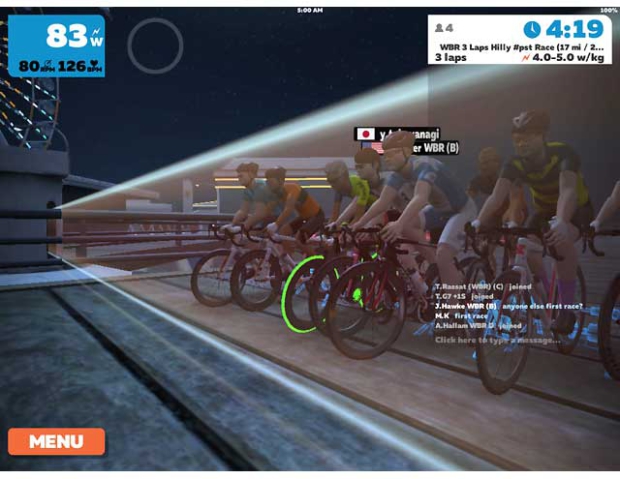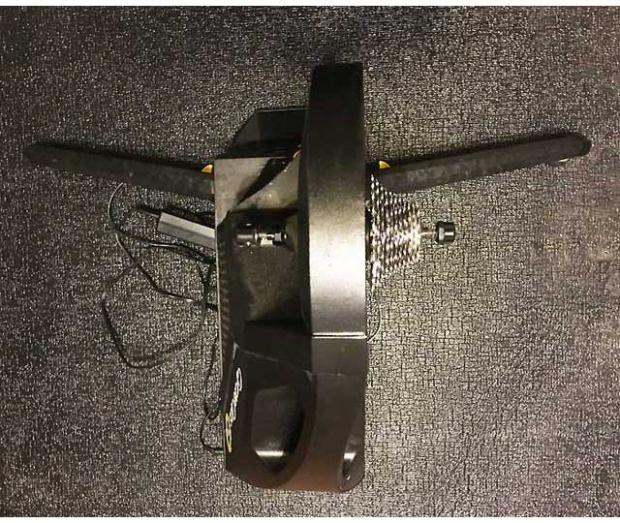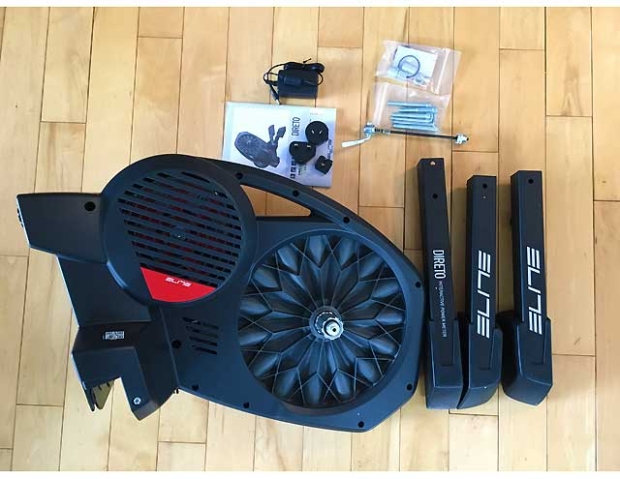How Does the Latest KICKR Compare?
It's February, and it's cold. Except indoor, where the riding is heating up! Slowtwitch just announced its second weekly Zwift event, the Hilly Vanilli. More questions are showing up on our Reader Forum: Which trainer to buy?
Wahoo first released its popular direct drive smart trainer in 2012, and the KICKR is now on its 3rd generation. This seemed a good time to talk about the updates, and how well or poorly it fares against other smart trainers.
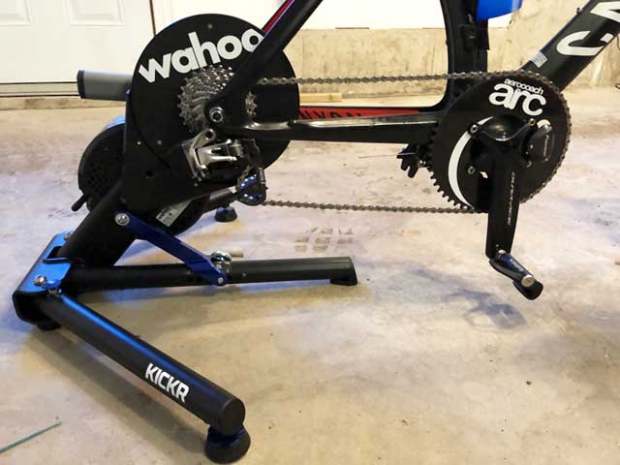
This latest iteration has only a few differences from the 2016 model, but it has come a long way since the original KICKR was overviewed here. I spent a few months aboard the 2017 model and, unsurprisingly, it remains a class leader in the smart trainer market.
Technical Specifications
Like most of the top tier smart trainers on the market today, the KICKR has a claimed power accuracy of +/- 2%, a max power output of 2000 Watts, and climb gradient of 20 percent. It supports Ant+, Ant+-FE-C, and Bluetooth Smart connectivity.
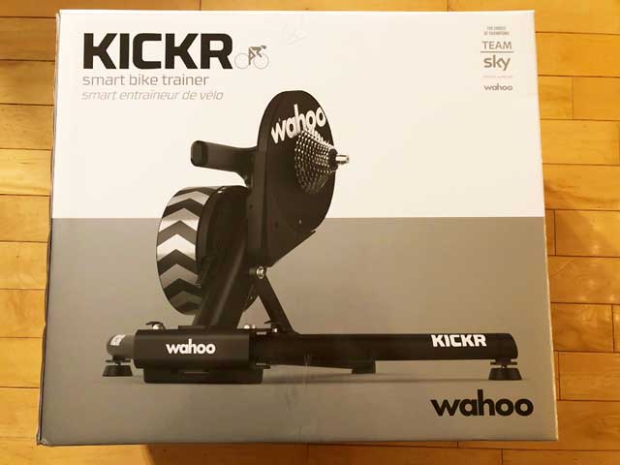
It also is compatible with 8, 9, and 10 speed Shimano/SRAM drivetrains along with 11 speed Campagnolo/Shimano/SRAM drivetrains. The 2017 KICKR is compatible with a bunch of hubs, including the 12x142mm and 12x148mm thru axle along with its KICKR CLIMB. The added compatibility for thru axles and the KICKR CLIMB are one of the updates to the 2017 KICKR.

All of the KICKR models provide speed, power, and distance information along with cadence when used with the included RPM cadence pod. Its frame has been time tested as durable, proven by the number of first generation KICKRs still operational today, including mine. The 2016 and 2017 KICKR models also include a handle for easier transport and connectivity LED lights found on the rear of the metal frame that confirm connection to peripheral devices (e.g., Ant+ via a flashing red; BTLE via solid blue).
Finally, the footprint of the KICKR hasn't changed since its inception, measuring 21" x 28" with legs open and 21" x 9" wide making it one of the most compact when folded and widest when open, but not necessarily the most stable and I'll discuss that later.
Competitors
The KICKR 2017 has to compete against itself, in that it has to provide a convincing value narrative to owners of a perfectly functional prior edition KICKR. It also must overcome the value offered by stalwarts such as the CycleOps HAMMER, Tacx NEO, and Elite's Direto and Drivo.
The 2017 KICKR, along with its enhanced capacity to pair with thru axle bikes (think about your future bike purchases!) is also quieter, has an attached handle, improved power accuracy, improved responsiveness and feel, and LED connection lights.
Getting Started: How do I use it?
Like most smart trainers today, the KICKR is as close to plug-and-play as there is, and there haven't been any set-up changes since the original model. The KICKR does not require a riser block or cassette (unlike the NEO and Elite models), assuming you're riding a 700c wheel with standard road tires. For most standard road or tri bikes, it is just a matter of releasing the stabilizing legs by pushing the blue button where each leg attaches to the KICKR body, connecting the bike to the rear dropout, and tightening the QR skewer.
Those with disc brakes, a thru axle, or 10-speed will have to change the included adapters or add spacers which are all included in the box. Those not using the typical road/tri bike tires (700C) also have the option of adjusting the height for from 24-inch road tires up to 29-inch mountain bike tires. Finally, each stabilizing leg has a turn-adjustable foot-pod to ensure the bike is level with floor.
Once this is completed, it is simply a matter of plugging in the KICKR to a power source, pairing the KICKR to either a Wahoo ELEMNT bike computer (or most newer Garmin Edge bike computers) or the various mobile applications or indoor software platform (e.g. TrainerRoad, Zwift, Rouvy, etc.), perform an initial spindown calibration and begin riding.
Let's Take Zwift, As One Example
You can load Zwift's software onto an iOS device, Windows 7 or higher, or an OSX computer (10.8 or better). If you enable Bluetooth in your OSX (Mac) computer or on your iOS phone or tablet, then you're set: The computer and the KICKR will automatically pair. Windows does not support bluetooth pairing; you must use an ANT+ dongle on Wndow's machines.
If you don't have Bluetooth capability in your computer, no worries. What you need is an ANT+ dongle, these are tiny and they work. Here is one for $16.99 that our publisher successfully uses for his weekly Slowtwitch Zwift rides, use a USB extension cable if you need the dongle closer to the device. If you want to be all-Wahoo, this company makes its own USB Ant+ kit, with the dongle and the extension.
If you have both wireless protocols enabled (an ANT+ dongle in your USB port and you have Bluetooth enabled), you make the choice on OSX. When you get to Zwift's pairing screen, and you click on "power source" (or controllable trainer), your KICKR will show up twice, once with the Bluetooth icon and once with the ANT icon. You can pick how you want to connect.
Power, Sound, and Performance Testing
In order to be consistent in testing indoor trainers, I have a few dedicated workouts for trainers that focus on some common interval durations (e.g., 10 seconds, 30 seconds, and 2, 5, 10, 20, 30 minutes). I also test across some common power ranges (200, 250, 300 watts) and then toss in some micro intervals or easy efforts (100 watts) where variations are more noticeable. Also, I repeat sound testing of each trainer to reduce the effect of ambient noise or drivetrain noise that could vary between tests.
Power accuracy and sound were one of the areas where the second and third generation KICKRs were reported to have improved over the first-generation model, and testing confirmed exactly that. The accuracy was impressive when gauged to the Garmin Vector 3s and Pioneer dual-leg power meter.
Sound
I tested the noise made by the KICKR 2017 using the SPLnFFT mobile application placed on the non-drive side of the KICKR. I repeat the same test conditions for each trainer by riding at approximately 200 watts at a cadence of 75-80rpms on a freshly lubed drivetrain with a straight chainline. My testing had the KICKR 2017 very slightly louder (less than 2db difference) than the Tacx NEO, making it the second quietist smart trainer I have tested. I also conducted sound tests at higher power (400+ watts) and the sound deviation remained consistent between the NEO and KICKR, although at higher wattages the subjective perception is the KICKR was louder, which may be a function of tone differences rather that sound output.
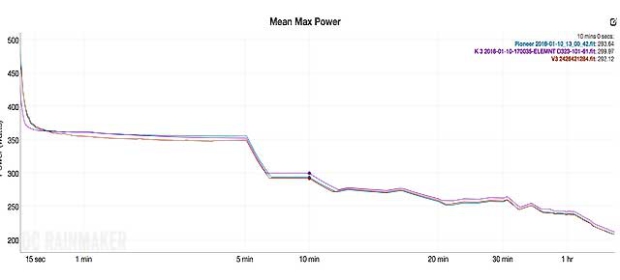
Power
Wahoo thought outside the box when it modified its power algorithms for the 2017 KICKR. It eliminated the use of strain gauges and in essence doesn't have what most consider a "real" power meter, unlike its first-generation model. The 2016 and 2017 models derive power primarily from the amount of brake resistance applied, along with increasing the number of environmental sensors.
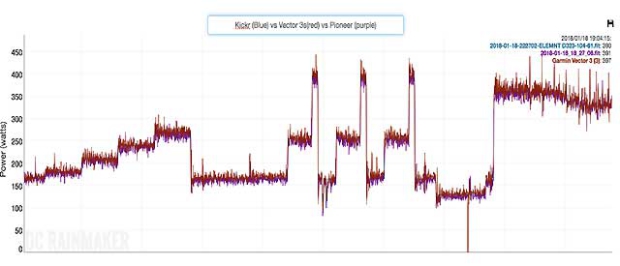
The result, according to Wahoo, was improved power accuracy, fewer calibration issues, and improved durability. In fact, although Wahoo claims the power accuracy to be +/- 2%, they state those numbers apply to outlier wattages such as fewer than 100 watts and more than 800 watts. Sweet spot wattages will be closer, they say and my testing demonstrated that, as can be seen in the images above and below, indicating a power accuracy on par with the Tacx NEO and Elite Direto.
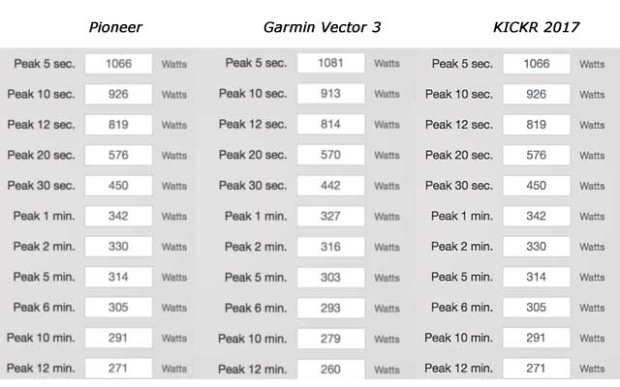
Performance
Performance, or feel, can be difficult to objectively quantify when comparing trainers with similar technical specifications. There is some performance convergence among the models in the $1000+ category of smart trainers, as the important features are now identified and the companies have shorn up their weaknesses. Differences are often subjective and minute, as was the case with KICKR 2017.
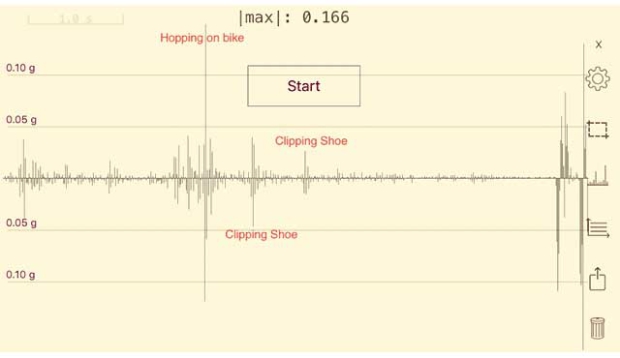
The KICKR was on par, in road feel, with its competitors, with the only exception being downhill rides on ZWIFT where the Tacx NEO does a better job of simulating downhill grades. Also, the NEO's "road feel" feature is found only on the NEO. The upcoming release of the KICKR CLIMB may neutralize this difference. The above photo indicates the amount of vibration emitting from the KICKR at 200 watts and 80 rpms tested via a mobile application, the device placed directly on the KICKR. As can be seen above, the vibration is minimal, and shouldn't be an issue for neighbors who live below your pain cave.
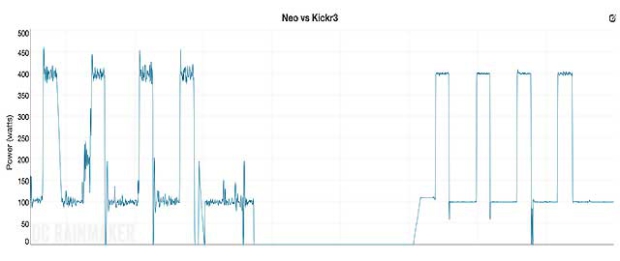
During my testing, there were a few detectable performance differences I noted between the KICKR and Tacx NEO, some that arise from dropouts or power spikes. The NEO occasionally has resistance lock, or significant resistance increase, for no apparent reason and suddenly a 100-watt recovery interval will spike in power, as can be seen in the second interval above (where the resistance increased prior to the second 400-watt interval). This is not an isolated incident with the NEO and is something I have not experienced with the KICKR. I have seen the same complaint from other Tacx NEO owners online. Also, as can be observed in the first 4 intervals done on the NEO, the first few seconds of an interval the NEO overshoots the target power and then smooths out. This was also validated from power readings from the Vectors and Pioneer power meters. The KICKR 2017 is a bit slower to hit target power but much smoother in doing so than the NEO. However, this also means the KICKR 2017 has difficulty hitting target power, or measuring power, in micro intervals (fewer than 5 seconds) when compared to the NEO or a standard power meter.
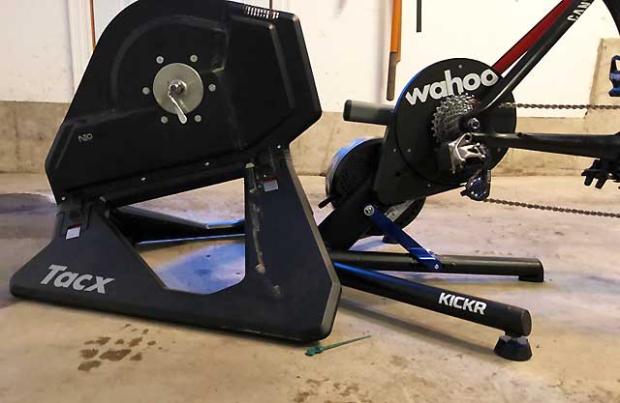
Finally, although the footprint and weight dimensions of the NEO and the KICKR are similar, the design of the NEO makes it more stable at higher power outputs (1000 Watts+) or if a rider gets out of the saddle and rocks the bike. I believe this is a function of the NEO's design where the platform style legs of the NEO balance it on the floor whereas the KICKR relies only on the small adjustable foot pods (shown in above photo), with the trade-off being increased stability (NEO) versus ability to adjust for uneven surfaces (KICKR).
Software
Unlike most of the other smart trainer companies, Wahoo doesn't have software specifically for use with the KICKR. Why would it? Wahoo's apparent wager that software companies would fill that void has paid off.
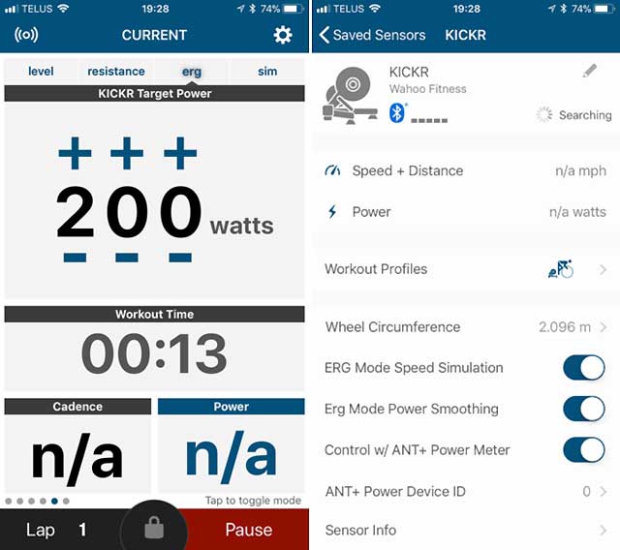
Wahoo does have a very basic mobile application, Wahoo Fitness, that would allow a user to control level, resistance, target watts, and slope, along with allowing for software updates for the KICKR, but it is rather rudimentary compared to other applications. It does allow for power matching with an external power meter via "Control w/Ant+ Power Meter". In fact, the ELEMNT line of bike computers and most training platforms allow for calibration and resistance adjustment, rendering the mobile application redundant.
Practical Considerations
The flawless and simple integration between the KICKR and Wahoo's bike computer line is definitely something to consider when purchasing either a KICKR or the ELEMENT bike computers. Its ability to control the KICKR for resistance-controlled workouts, pull structured workouts from various sites (e.g. TrainingPeaks, Today's Plan) or .GPX routes for route simulations are all features I use daily.
A more difficult consideration is whether one should upgrade from Wahoo's version 1 or 2 of the KICKR to the 2017 model. The improved sound, accuracy, and feel between their first model and the 2017 KICKR is substantial enough to consider upgrading However, unless one foresees purchasing the KICKR CLIMB, there really isn't a strong argument to upgrade from the second generation KICKR. Further, until I test the KICKR CLIMB I can offer no guidance on it. That established, Slowtwitch should be testing the product shortly and Wahoo has confirmed that public release is now set for April 2018.
Final Thoughts
Wahoo has almost closed the gap between the KICKR and the Tacx NEO, heretofore arguably the top smart trainer (and priced accordingly) in terms of power accuracy, feel, sound and compatibility. Among similarly priced competitors (such as CycleOps' formidable HAMMER), the KICKR is a formidable competitor. Wahoo clearly improved upon its original model, and the remaining question is whether the integration with the KICKR CLIMB will push the KICKR 2017 to the front of the smart trainer market.


